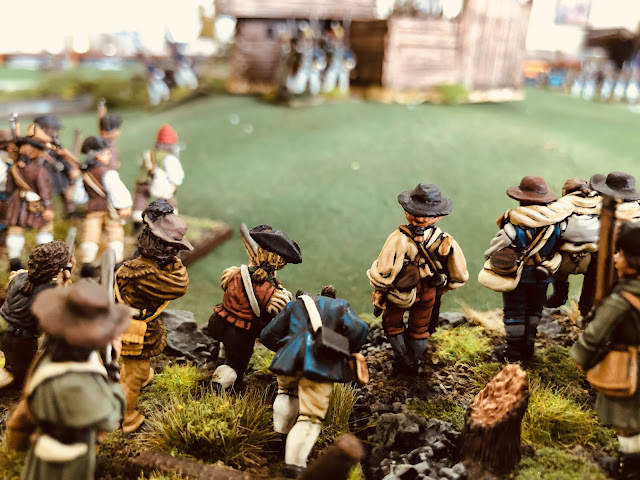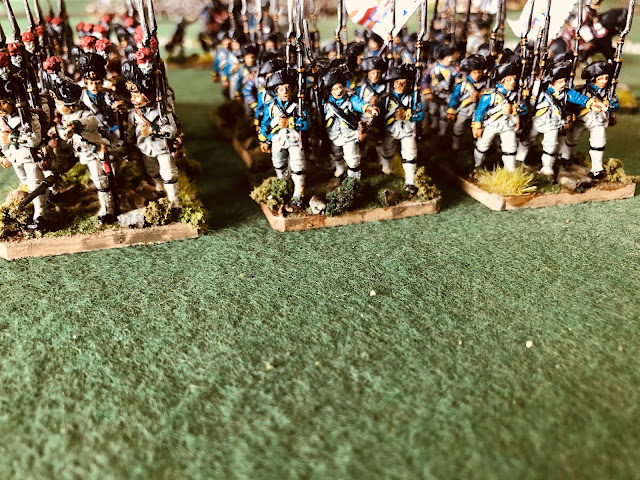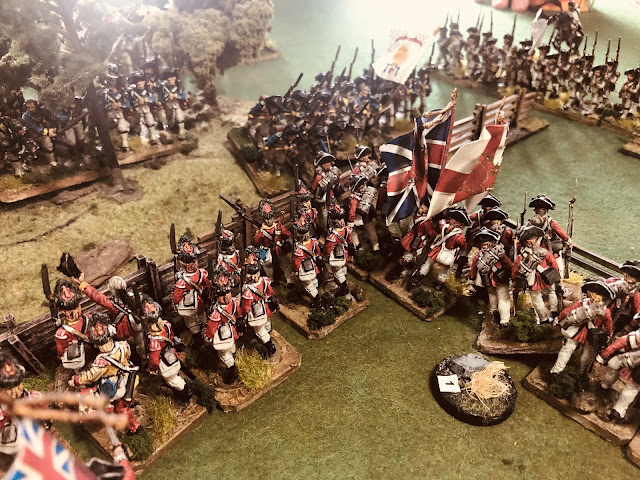Yesterday we played an American War of Independence game.
Often in our games we have reinforcements arriving during the game, but usually they are at the discretion of the umpire. I wanted to do something a little different. I wanted to start the game with a small force on each side and allow it to be reinforced, but calling reinforcements had to have a consequence. So this game is to be the first of two and decisions made in this one will have an impact in the next.
The basis of the game is that a Hessian force is holding a position at X (below) being attacked by an American force. The Hessians are not strong enough to hold the position without reinforcement. They can draw on reinforcements from their home bases at A and B (two brigades at A and three at B), but if they lose this fight they will need to fall back on their home base and if they strip too many reinforcements they may find themselves disadvantaged in the second fight. The British have an additional source support. There are allied Indians in the area, but no one, even the British, know where they are. Whenever an American unit enters an area of woods 1xD6 is rolled and of a 5 of 6 is rolled mean that they have encountered Indians, and a second roll of 5 or 6 means that they have been ambushed.
Similarly the attacking an Americans are not strong enough to drive the Hessians without reinforcements which they can draw on from C and D and they too have to be mindful of the second fight. The American force is stronger that the British, but the Americans have a number of raw militia which come with their own complication. The battlefield, X, and the American bases of C and D are in New Jersey while the British bases, A and B, are in New York and the militia cannot serve outside New Jersey, so would not be available in the in a battle at A or B, and the Americans need to decide how to best use them.
Two other things players need to consider. First is that losses are carried forward, so any reckless attacks will have a consequence. Second, lines of retreat need to be considered too because should only one be available to the defeated army, the consequence of crowded roads could lead to the disintegration of retreating units.
The map below shows the initial deployment and potential arrival points for reinforcements.
So what happened in the game? Well wargamers being wargamers, all three American players brought their entire force onto the table, completely stripping their home bases of troops. The British chose to bring their entire force at A, a total of six battalions and two guns, while the commander of force at B was hedging his bets, waiting to see if an opportunity arose, but protecting the home base.































Glorious looking game!
ReplyDeleteThanks Steve. It was good to get a good mix of figures on the table, from Perry, Frbont Rank and others.
DeleteThe next game will be interesting. The American decision to commit all the reserves from the beginning nearly paid dividends. Will the British gain any bonus for having fresh reserves?
ReplyDeleteThe British will hold a good position for not committing those brigades and with the Americans losing six units of militia the numbers are now even. I am planning the table now, but the game probably won't be played until late November- early December.
DeleteExcellent stuff there Mark and some nice, simple mechanics for this mini-campaign. It will be interesting to see if the American gamble of putting everything into the first fight pays off, ditto the Hessians etc keeping their LoC secure and a base to fall back upon. Looking forward to seeing what happens:).
ReplyDeleteIf the American gamble hadn't worked they would have been in quite a bit of strife getting back to their home base because their LoC was more awkward. The Brits played it well in the end, probably not be intent though. Had the Americans on the extreme right pushed hard they might have done much more damage, but the threat of further British reinforcement held that force in place.
DeleteGreat looking game and a very good read too. It's good that both armies are still primed and ready to go at it again, be interesting to see what happens next.
ReplyDeleteThanks Donnie. Neither side was too severely knocked about so the next fight should be interesting.
DeleteFancy set up and idea to have choices matter. Interesting to see how it plays out. 😁
ReplyDeleteIt was an interesting setup, but risk and consequence are hard things to represent in a wargame unless you tie it to something tangible. I remember that veteran wargamers Brigadier Peter Young once wrote that the only way to introduce risk to a wargame was that whenever a player loses a casualty he hands over one of his carefully painted figures to his opponent who then flattens it with a two-pound hammer.
DeleteGreat looking table and figures. The scenario is brilliant! Looking forward to the second battle. I will have to try thus one out myself. Very well done sir!
ReplyDeleteThanks Mark. It kept seven of us entertained for a few hours.
DeleteSmart scenario and great looking game ,neatly poised for the next, I guess the American player had to use their militia in this game as they couldn't use them in New York?
ReplyDeleteBest Iain
Thanks Iain. In the end the Americans won the fight with just one command, while the other two watched, but the next game will be pretty finely balanced.
DeleteSeemed to work out well Mark and the next game should be a doozy!
ReplyDeleteI certainly want to make the next one a challenge...probably won't be until December, so you should be able attend!
DeleteThat's excellent news 😀
DeleteWe should be able to get some if your additions on the table
Delete